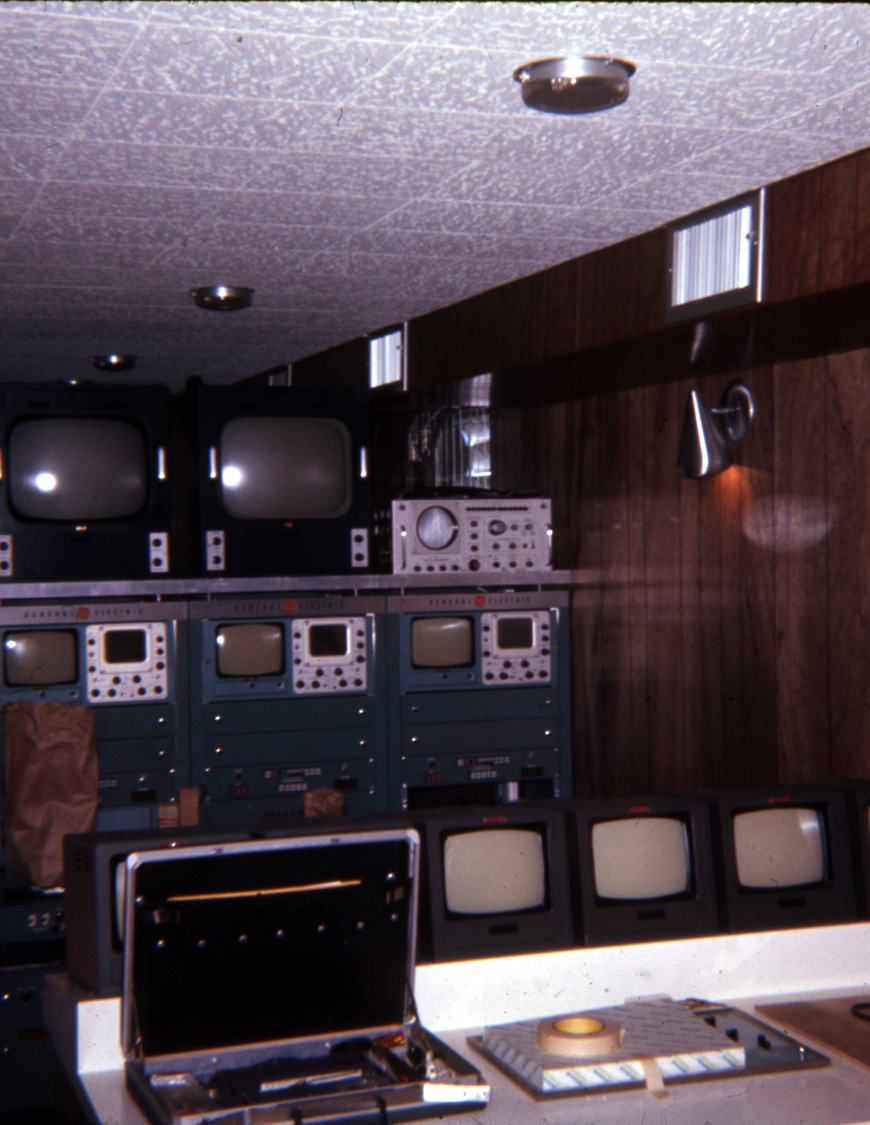
Here, There, and Everywhere
Faced with a vast engineering refit to fully equip the 1960 mobile unit for color, a decision was made to send the vehicle to Gaylord's newly acquired WUFH in Milwaukee and create an entirely new color unit for WTVT.

Going Places! This color mobile unit received heavy
use from CBS, ABC,
and independent producers.
Newly appointed Chief Engineer Lawton Metcalfe supervised construction of the color truck, which was capable of using three color cameras. Although not as lengthy as the 1960 unit, the new mobile facility had the same compliment of camera control panels, director's area, audio console, and tape room, only much more compact and compartmentalized. General Electric color cameras were chosen for the color unit for two reasons: Engineers and production personnel were under whelmed with the picture quality and maintenance requirements of the RCA TK-42s used in the studios. The General Electric cameras use of lead oxide tubes (similar to Plumbicon tubes) produced far less lag and a better color picture than the TK-42.
 |
 |
|
Interior of the 1968 mobile unit |
Three GE PE-350s were used on the color unit |
The color unit's first remote was the 1968 Gasparilla invasion and parade as seen in the photos above (courtesy Earl Higgins).
The color unit was used extensively on a syndicated religious program, "Day of Discovery," taped at Cypress Gardens. Along with Channel 13 engineers, the mobile unit was called to duty for an appearance in the 1968 motion picture "Marooned," filmed at the Kennedy Space Center.

The Hollywood-based Columbia Pictures crew setting up a shot of the Cape
Canaveral press area.
The Channel 13 mobile unit's WTVT signage is covered with CBS branding.
Note the blue Norelco PC-70 cameras. These are non-working props.
|
|
|
Channel 13's 1968 logos are visible on the cameras in this frame from "Marooned" |
|
|
| Engineer Frank Rankel (center) places a GE PE-350 on a Houston-Fearless Tripod/Head |
|
|
|
Cameras are in place as the WTVT mobile unit is
visible in the background |
The General Electric cameras were used for only two years when at the request of network clients, Norelco PC-70 cameras were installed. By that time, the PC-70 (made by Philips) was firmly established as the industry standard having proved their versatility in many different remote scenarios.
|
|
|
|
Steve Grayson on a remote at Busch Gardens (1975). |
All Systems Go! Live coverage from Cape Canaveral |
The WTVT remote truck became one of central Florida's busiest color mobile facilities. Staffed by Channel 13 cameramen and engineers, the mobile unit was used for numerous space launches at Cape Canaveral. CBS and ABC regularly used the mobile unit for regional football and baseball. KTTV, Los Angeles, rented the mobile unit and 13 crew for pre-season Dodger baseball. Other clients included "The Merv Griffin Show," "The George Jones/Tammy Wynette Show," and the previously mentioned "Day of Discovery".
Although the Norelcos provided superior performance, they used 1" thick coax cable. On stadium remotes, the runs could add up to hundreds of feet of the heavy, delicate cable that had to be funneled, flown, or snaked from the truck to the camera platform. Cabling a location and then striking it later was the hardest part of all remotes, so it was a blessing for the crew when triax cable, only 1/4" thick, was introduced in the 1980's. The PC-70's were eventually replaced by Philip's LDK-5 cameras.

Vic Dashiell and Todd DeBonis mount a Philips LDK-5 at Tampa Stadium (1978)